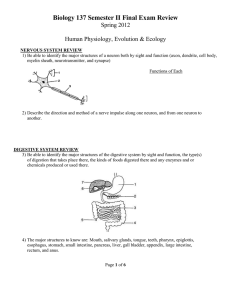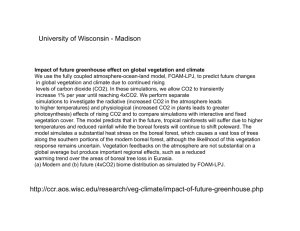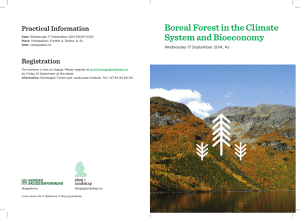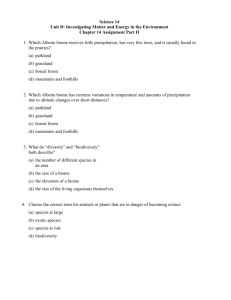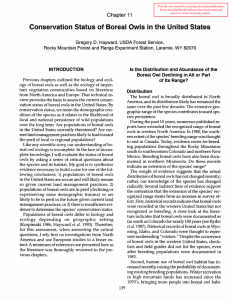Alvin-Boreal Forest Handout
advertisement
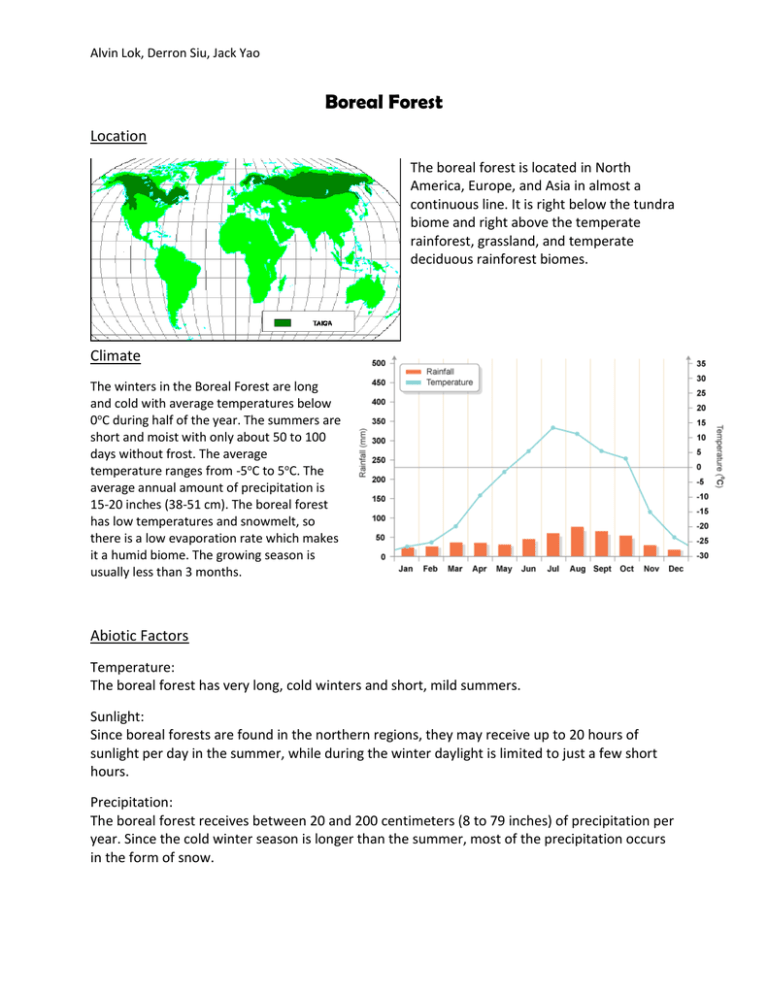
Alvin Lok, Derron Siu, Jack Yao Boreal Forest Location The boreal forest is located in North America, Europe, and Asia in almost a continuous line. It is right below the tundra biome and right above the temperate rainforest, grassland, and temperate deciduous rainforest biomes. Climate The winters in the Boreal Forest are long and cold with average temperatures below 0oC during half of the year. The summers are short and moist with only about 50 to 100 days without frost. The average temperature ranges from -5oC to 5oC. The average annual amount of precipitation is 15-20 inches (38-51 cm). The boreal forest has low temperatures and snowmelt, so there is a low evaporation rate which makes it a humid biome. The growing season is usually less than 3 months. Abiotic Factors Temperature: The boreal forest has very long, cold winters and short, mild summers. Sunlight: Since boreal forests are found in the northern regions, they may receive up to 20 hours of sunlight per day in the summer, while during the winter daylight is limited to just a few short hours. Precipitation: The boreal forest receives between 20 and 200 centimeters (8 to 79 inches) of precipitation per year. Since the cold winter season is longer than the summer, most of the precipitation occurs in the form of snow. Food Chain Endangered Species The whooping crane is an endangered species which lives in the boreal forest biome. It is listed as globally endangered by the World Conservation Union. The whooping crane is the tallest bird in North America and one of the oldest birds on Earth. This species is endangered because its habitat and food sources are getting destroyed due to human development. Humans are draining marshes for farms which are destroying the whooping crane’s habitat. This also destroys the whooping crane’s food source because the marshes are also where they find their food. There are now a reduced amount of marshes remaining in North America for the birds to rest and eat when they are migrating. Currently, the birds are protected under the Federal Species at Risk Act. There is also a cooperative recovery effort between Canada and the United States. Before 1996, there were many captive breeding programs already in place in the US, but since 1993, a captive breeding centre was created in the Calgary Zoo and in its first 11 years, there were 20 offspring produced and they were released into the wild. There is a breeding area in Wood Buffalo National Park for whooping cranes and it is protected along with other sites where the whooping cranes stop during their migration. The birds migrate to Aransas National Wildlife Refuge in Texas, or somewhere near it. Adaptation of Species: Plants: Firs, spruces, and pines are the dominant are the main trees in the boreal forest because they are have adapted to the cold conditions and short growing season. Trees in this region have a conical shape, needle leafs, evergreen habit, and dark colour. The conical shape helps shed the snow and reduces the loss of branches. The needle leaves reduce the surface area so water can be conserved. This is needed because in the winter, the ground is frozen, so there is no water. The plants have an evergreen habit because then the plants can photosynthesize right when the temperature is right, so they do not waste time during the growing season, which is very short. Finally, they have a dark colour because it helps the plants absorb as much heat from the sun as it can, so it can photosynthesize earlier. Animals: Animals in the taiga adapted in this biome by hibernating, storing food, migrating, and having physical attributes. Some of the animals live through the cold winters by sleeping through them. This makes it possible for the animals to little or no food at all through the winter. Some animals that hibernate are ground squirrels, badgers, and the wood frog. Small animals store food in dens or burrows. This helps them because they don’t have to look for food during the winter because they did that before. Many birds migrate south in the winter and go back in the spring and summer to breed. This allows them to benefit from the boreal forest’s wetlands and plants minus having the risks of the severe winters. Some animals that do this are songbirds, water fowl and moose. The animals that stay in the boreal forest throughout the entire year have physical adaptations like thick fur, camouflage, and wide feet to help them survive the winter. Human Impact Humans have made a big impact on boreal forests. Some examples are forestry, mining, oil and gas extraction, power generation, and global warming. Forestry is Canada’s biggest natural resource industry and many communities depend on the forestry industry for the community’s survival. There is lots of oil under boreal forests and more demand for oil may force oil exploration in these forests, then forest land may be removed for roads and pipelines. Large hydroelectric projects can also impact boreal forests because these projects can remove trees and clear land which removes wildlife habitats and affect the populations of species. This can change how an ecosystem functions. What can be done to reduce the impact is looking at the management of boreal forests. For example if trees are cut down, then that area should be reforested (replanted with new trees). Also, better regulation by the government would also help.



